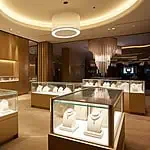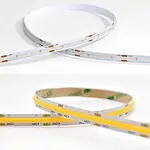The first thing that hits your mind thinking of the sauna is surely the hot air that sweats you up. But have you considered whether the regular fixtures you use daily are robust enough to withstand such a hot and humid environment? The answer is a big No.
When lighting a sauna, you need fixtures designed specifically for saunas. These lights must be heat tolerant, which can withstand temperatures up to 100°C. Though saunas don’t come in direct contact with water, the room’s humidity produces water vapor due to heating. So, the fixture you choose should be moisture-proof. The other factors to consider for sauna lighting include- CCT, CRI, IP rating, etc.
Continue reading to explore more about sauna lighting. At the end of the article, I have added some ideas you can implement for your sauna lighting project. So, Why wait any more? Let’s get into the discussion:
What Is Sauna Light?
Sauna lights are designed for sauna rooms where people relax in dry or moist heat sessions. The temperature of the sauna usually ranges from 90°F to 194°F (32°C to 95°C) based on the type of sauna. So, to withstand this temperature, the fixtures used in the sauna are built to resist heat and moisture. Besides, they have a waterproof body and are completely sealed.
Though the general purpose of sauna lighting is to provide sufficient visibility, light also plays a crucial role in relaxation. Warm lights are considered best for saunas. The warm and soft hue of the yellow light calms you and relaxes your body. Besides, chromotherapy lights are used in infrared saunas. You can adjust the color of these lights, which brings certain benefits. For example, it relieves pain and improves mood. To learn the influence of light color on your mood, check this- How To Use LED Light Colors For Different Moods?
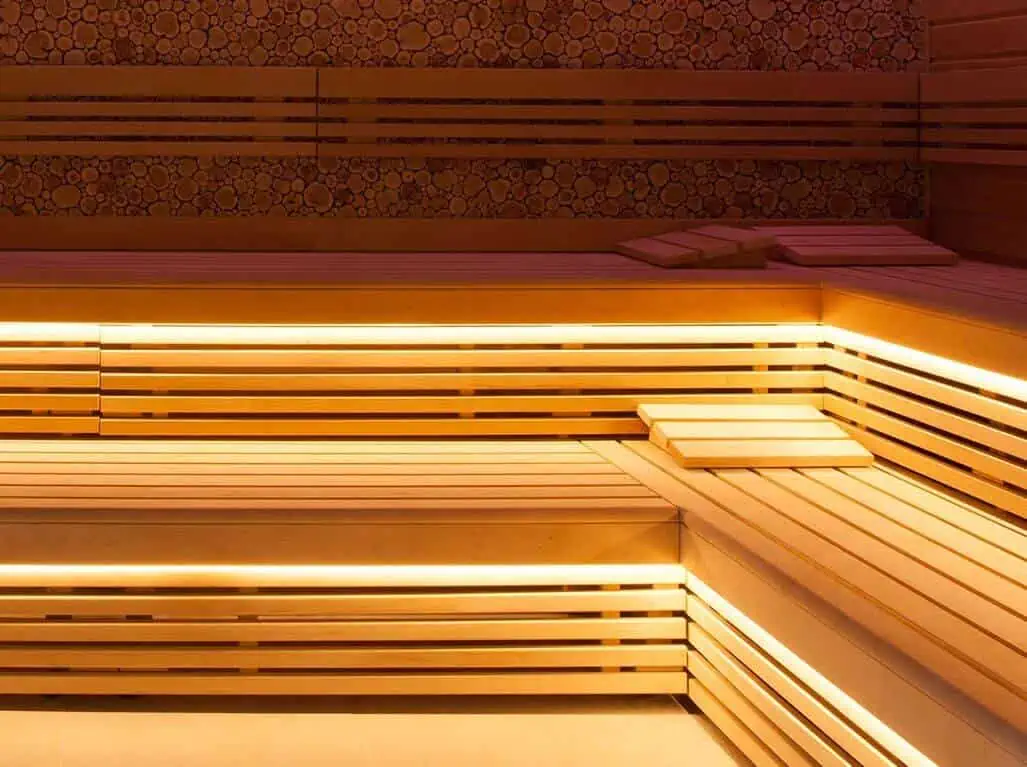
Types Of Sauna Light
The lights used in saunas can be divided into three categories based on the technology. These are as follows-
Incandescent Lights
Incandescent lights are the traditional form of sauna lights. They have been used in saunas for years. The filaments in incandescent lights bring a rustic look to the wooden sauna. This complements best for traditional style saunas.
However, the power of the incandescent light is a crucial consideration when installing them in saunas. This is because incandescent technology emits 80% of the energy as heat and only 20% as light. The sauna’s temperature is already too warm, and the fixtures’ warmth contributes to the room’s temperature rise. Thus, the additional heat input of the light can overheat the fixture, causing an accident. So, you shouldn’t use incandescent over 60W.
LED Lights
LEDs are the most energy-efficient lighting option for saunas. They are eco-friendly and operate at low temperatures, reducing the risk of overheating issues. LED lights fit best for infrared saunas and operate most effectively in environments between 100° and 140°F. The wide range of variety allows you to add multiple light colors to provide relaxation and mood lighting for saunas. Besides, they have many advanced features that uplift the user experience of your sauna. You will also get more control over your lighting using LED fixtures. The most common variants of LED lights used in saunas include- For more information, you can check Advantages and Disadvantages of LED Lighting.
- LED Strip Lights
LED strip lights are widely used in modern saunas. The indirect and hidden lighting effect of strip lights prevents glaring and provides a cozy ambiance. Cove lighting with LED strip lights works best for general lighting. You can also install them under the sauna benches and highlight niches. However, standard LED strip lights are not suitable for saunas. You need to look for specialized LED strips for the sauna that have high heat resistance and are moisture-proof.
- Recessed Lights
Recessed lights blend seamlessly with the sauna ceiling. Thus, you will get a neat and even lighting using these fixtures. The recessed light designed for saunas has heat-resistant housings that withstand temperatures up to 195°F or 90°C. If you have an insulated sauna, ensure your recessed lights are IC-rated. To learn more, read this- IC Vs. Non-IC Rated Recessed Light Fixtures.
- LED Bar Light
LED bar lights are a popular choice for saunas. They are available in varying sizes that you can use to illuminate different zones of the room. These lights also allow you to install horizontally and vertically on the walls or beneath benches. But before you purchase bar lights, ensure they are designed for the sauna or heat and moisture-resistant.
Optical Systems
If you have a Russian sauna, an optical lighting system is what you need. Such lighting doesn’t require electricity. Instead, this technology uses light waves to generate light. So, you can place them outdoors where there is no electricity connection. Optical sauna lights can resist heat up to 200° C or 395°F. Thus, there is no potential risk related to temperature tolerance. You can fit them on the ceiling of your sauna and enjoy a cozy, stay vibe while relaxing.
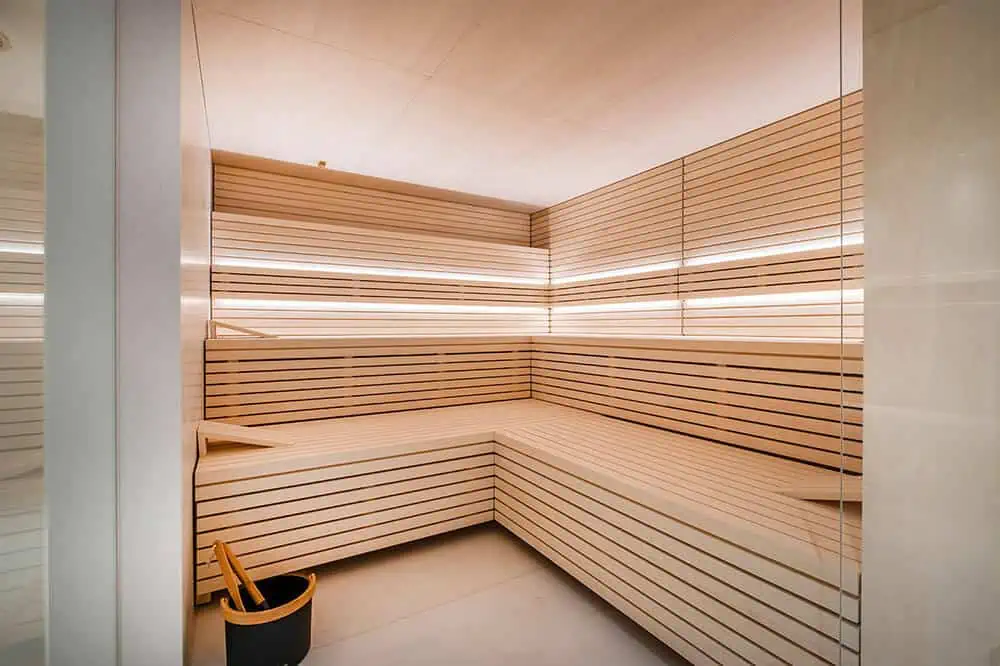
Consideration For Choosing The Right Sauna Light
As sauna lights are different from regular lights, you need to be more careful in choosing the correct fixture. Here is what you need to consider:
Decide On The Ambiance: Dark Or Bright Sauna
Before lighting up your sauna, consider what ambiance you want to keep. Usually, soft lights are preferred for sauna lighting. Most saunas are dark-lit to create a cozy vibe, as too bright lights can cause glaring issues. However, when choosing the ambiance and brightness of light, you must consider the age group. For instance, a 60-year-old person will require brighter light to see in comparison to a 20-year-old man. So, a dimmable light fixture in the sauna should be used to adjust the brightness for the best result. For more information, you can check How to Dim LED Strip Lights.
Moisture & Water Resistance
Water resistance is crucial for saunas, especially in a moist heat session. Though the fixtures don’t come in direct water contact, they face water vapor. In traditional saunas, rocks are heated to increase the room temperature. As the sauna heats up, the moisture present in the room is converted to water vapor. The sauna lights must have a higher IP rating to withstand such an environment. IP65 is best for saunas; it protects against water jets and is completely dustproof.
Nevertheless, you need not spend money on going for a rating higher than IP65 as the sauna light faces water vapor only. The fixture won’t come in direct water contact. To learn more about IP rating, check this- IP Rating: The Definitive Guide.
Temperature Resistance
To decide on the heat resistance of the fixture, you must consider the type of sauna. Traditional saunas have a high temperature that ranges from 100°F to 140°F. And if it’s a Finnish sauna, the temperature will remain between 160°F to 194°F. To withstand such high temperatures, you must purchase fixtures that are designed especially for sauna lighting. The temperature resistance levels for different sauna types are as follows:
| Type Of Sauna | Heat Source | Lights’ Temperature Resistance |
| Finnish sauna | Gas/electric/wood | 160°F to 194°F (71°C – 90°C) |
| Infrared sauna | Infrared heating elements | 100°F to 150°F (38°C – 65.5°C) |
| Portable sauna | Infrared heating panels | 100°F to 150°F (38°C – 65.5°C) |
| Steam sauna | Steam Generator | 90°F to 120°F (32°C – 49°C) |
Construction Materials
Saunas are mostly made of wood. And yellowish or warm tone light suits wooden saunas best. However, modern saunas are now far more than the typical wood color. Black saunas are gaining popularity. In such saunas, you need to keep the lumen rating of the bulb a bit higher than the traditional sauna. This is because black absorbs light, so to balance the light, go for brighter lights compared to wooden saunas. You can experiment with higher CCT for black saunas per the light color. But don’t go for too cool colors that contrast coziness.
Most interestingly, tile saunas are also seen in households. Though flashy tiles aren’t used for saunas, if you have one, check the light brightness. Tiles tend to reflect light, so you can keep the lumen ratings minimal for soft, glare-free lighting.
Installation Area
The extent of light contact with heat and moisture differs for different sauna zones. For instance, the fixtures in the sauna washroom don’t face the hot temperature of the sauna steam room. Again, the humidity of a steam sauna and a dry air sauna is also different. Therefore, here are the lighting requirements you need to consider while installing fixtures in different zones of the sauna:
| Sauna Area | Lighting Considerations |
| Steam Room | The humidity of steam rooms can reach up to 100%. So, you must use water-resistant fixtures that can withstand water vapor and moisture. Temperature consideration is the major factor here. The fixture you use must resist heat of at least 90℃ to 100℃. Avoid installing lights that get direct hot steam from the sauna heater. Even though the lights are heat resistant, don’t overexposure them to heat for safety. The best option is to install horizontal fixtures at the mid-level of the walls. LED strips work great for such lighting, but you can also use bar lighting. Besides, glass-sealed recessed lights are also popular for sauna ceilings. However, the safest option for a steam room is ceramic base lamps or stainless steel, aluminum, heat-resistant fixtures. |
| Sauna With Dry Air | Dry-air saunas have higher temperatures than steam room saunas. However, these saunas have low humility compared to steam saunas. Your fixture must be highly heat resistant to withstand the hot temperature. For Finnish saunas, ceramic base lamps are essential. |
| Sauna Washroom | The sauna washrooms are like normal washrooms; they don’t go through high temperatures. So, a fixture that can tolerate the warmth of a hot bath is enough. However, you need to check on the IP rating for the washroom. Divide the washroom into four zones and install suitable fixtures for the spot. Zone 0: Inside the bath or shower itself At least IP67; total immersion proof Zone 1: Spaces directly above a shower or bath The area above the bath to a height of 2.25m from the floor IP65 rating is recommended Zone 2: Space around the bath area stretching 0.6m outside the perimeter of the bath and to a height of 2.25m from the floor Consider the wash basin and surrounding area At least IP44 Zone 3: Anywhere outside zones 0, 1, and 2 Doesn’t face water jets Water resistance is not essential  |
Color Temperature
The color temperature of the fixture determines the light color of the sauna. The lower color temperature that gives off yellowish light is ideal for a sauna. You can go for 2700K lights to get the best ambiance in the sauna. The soft warmth of this hue will create a cozy environment where you can relax. If you want less yellow tone to your light, you can go for the 3000K to 3500K CCT range. These fixtures give a light yellow lighting with more of a white tone. These lights are popular in modern saunas and don’t fit too much in the orange light tone. However, avoid installing high CCT lights with bluish hues; for instance – 5000K or around. This color temperature is not ideal for saunas as they won’t aid in adding a relaxing touch to the ambiance.
For more information, you can check below:
Best Color Temperature for LED Office Lighting
Understanding the Differences Between 4000K and 5000K LED Color Temperatures
How To Choose A Color Temperature For A Bathroom?
How To Choose A Bedroom Lighting Color Temperature?
How to Choose LED Strip Color Temperature?
Color Rendering Index (CRI)
What if the expensive wooden textures on your sauna look pale in lighting? To avoid such circumstances, you must always consider CRI before purchasing fixtures. It indicates the appearance of the real color of an object under artificial lighting compared to natural light. Higher CRI indicates more color accuracy. So, you should look for fixtures with CRI>90 for the best experience. This will ensure the real color of your wooden sauna and the textures appear accurate.
For more information, you can check below:
What is CRI?
TM-30-15: A New Method for Measuring Color Rendition
Safety Standards
To ensure the sauna lights are of standard grade, you must go through its certification. Consider LM80, ETL, CB, CE, and RoHS certifications. You should also check if the product goes through a temperature and humidity test. We proudly claim that our LEDYi sauna lights pass through all these tests; you will find the test report on our website. Therefore, if you’re looking for professional standard sauna LED strip lights, LEDYi is your best option. For more information, you can check The Certification of LED Strip Lights.
Life Span & Warranty
Life span is crucial in ensuring your sauna lights last longer without any replacement requirements. LED lights are durable and last much longer than traditional lights. So, regarding lifespan, nothing can beat LED sauna lights; they can last up to 50,000 hours and more. Nevertheless, consider purchasing a fixture from a reputable brand with a solid warranty policy. This will ensure high performance of fixtures and build reliability. Our LEDYi sauna lights come with a 3-year warranty, so no worries about quality. Above all, our lights have a lifespan of more than 60,000 hours! For more information, you can check How Long Do LED Strip Lights Last?
Sauna Light: LED Strip Vs. Light Bars Sauna
LED stripes and bar lights are the most popular lighting options for saunas. Now, deciding between these two is something you might face. Check out the differences to choose the best one:
- Variation In Length
The most crucial fact that favors LED strips is their flexibility. You are not limited to any length. These strip lights come in reels. You can cut them to your desired length; the cut marks in the PCB make the sizing procedure much easier. Here is the guide for cutting LED strips: Can You Cut LED Strip Lights and How To Connect: Full Guide.
In contrast, LED bar lights come in a fixed size. So, you might not get the length you want in your sauna. Though there is a customization option, you will need to contact light manufacturers, which will increase the cost.
- Flexibility of Installation
The bending feature of LED strip lights provides you with greater flexibility during installation. You can fold them and insert them in the corners of your sauna. This guide will help you learn the corner light installation method: How To Install LED Strip Lights Around Corners? Thus, you will get continuous and uniform lighting throughout the sauna ceiling or benches. Meanwhile, LED bar lights are rigid fixtures; bending them will surely break the lights. So, if you want a more professional finish, LED strips are best.
- Cost
Installing LED strip lights will save you money. These sauna lights are more affordable than LED bar lights. You will also get more advanced controlling features in strip light that LED bar light lacks.
Considering all these features, an LED strip light is better for saunas than an LED bar light. Besides, you will also get a more modern vibe to your sauna by installing LED strips.
Top 8 Ideas For Professional Sauna Lighting
In this section, I will share some amazing ideas for lighting up your sauna like a pro. Check them out:
1. Consider Natural Lighting For Home Sauna
For daytime nature, lighting is always soothing. So, if you have enough facilities, prefer natural lighting for saunas. This works best if you have a scenic beauty on the other side of the window, just as in the above picture. The sunlight peeping from outside will bring a homey ambiance to the sauna. This sort of light setting is popular in the saunas of resorts. You can also implement this for your personal sauna at home. Another technique is to include a glass ceiling in the middle to let sunlight in. This also works great for outdoors, rooftops, or one-stored saunas.
2. Place LED Strip Lights Under The Sauna Benches
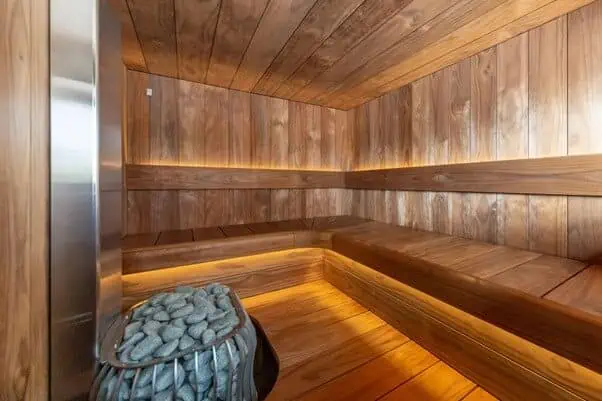
To do something different other than just illuminating the ceilings, target the branches of the sauna. LED strip lights are best for such light installation. Here, you need to mount the LED strips beneath the benches. Thus, it will create a floating effect and make it seem like it is sitting in the air; for better results, use high-density LED strip lights. This will prevent hotspot issues and provide you with smooth lighting. Follow the instructions in this guide to learn the method of installing light under benches: How to Light Shelves With LED Strips?
3. Hidden Lighting Technique
Hidden lighting is the best technique to avoid light glare. The light rays from direct lighting often feel irritating as they fall on the eye. To avoid such circumstances, you should mount lights so that the fixture remains invisible yet produces enough illumination. The above discussed under bench lighting is a good example. Besides, you can create a false ceiling and go for cove lighting for a hidden effect. For more ideas, check this- How To Hide LED Strip Lights?
4. Starry Night Effect With Optical Lighting
Want to enjoy the starry night effect in your sauna room? Install an optical lighting system and see the magic! The small spot-like illumination in the ceiling will take you to a fantasy world. To complement the ceiling light, keep the room’s general lighting dimmed. A dark sauna room with a lit ceiling will give you the celestial feel of relaxing in a sauna.
5. User Dimmer Switch For More Control Over Sauna Lighting
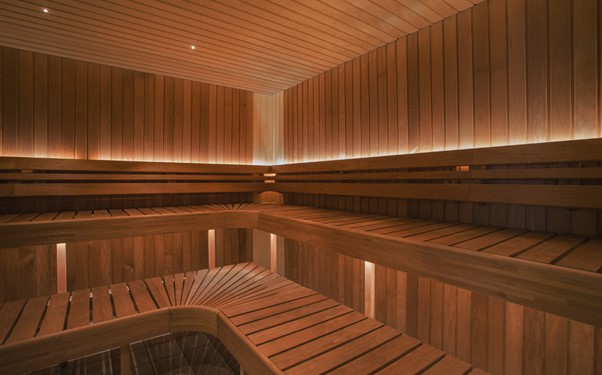
The lighting preference differs for individuals. For instance, you may prefer a dark sauna; others may want a well-lit ambiance. To satisfy these needs, the best you can do is to install a dimmer switch. This will allow you to control the brightness of the light. So, whenever you use the sauna, you can adjust the lights to fit your comfort zone. This technique is essential for commercial or public saunas to ensure customers get their desired ambiance.
6. Create Interesting Shadow
If you are tired of that basic lighting in the sauna, play with shadows. Purchased a patterned fixture for the sauna to create designed lighting. However, finding sauna-grade patterned fixtures can be difficult. So, best to go DIY. You can simply make patterned casings of wood, ceramic, or concrete. Then, insert light in it. Your eyes won’t believe what you have just created!
7. Use RGB LED Strips For A Colorful Vive
If you are so into colors, install LED RGB lights in your sauna. Using these lights, you can add multiple light colors to your space. The RGB lights combine the three primary colors, red, green, and blue, to produce millions of hues. Remote control lighting will give you more control over the ambiance. You can use them in your personal sauna for mood lighting. Besides, many spa centers also use colorful lights in saunas. If you are on a romantic spa date with your partner, these colorful lights in the sauna will surely add spark to your moment.
Troubleshooting Sauna Light Problems
While using sauna lights, you may go through some common lighting issues. Here is how to solve them:
1. Burned Out Bulb
Light burnout is common as sauna lights go through high temperatures. This happens more often when you use a regular fixture in a sauna. The fixtures can’t handle the increasing temperature of the room and eventually burst out. It becomes more serious when you use regular incandescent lights in saunas with a glass cover. The burst out of this light can be dangerous as they easily get overheated. The hot filament inside the bulb can even cause a fire. Besides, the broken glass pieces are also a danger to consider.
Solution:
- Use heat-resistant fixtures that are designed for sauna
- Avoid glass-covered fixtures for sauna
- Avoid installing the lights too close to the heater.
2. Loose Connections
The light wires might get loosened over time. This can cause the light to flicker or turn off suddenly. Here is what you need to do to solve this problem-
Solution:
- Check the wires and install them properly
- Avoid keeping any hanging wires in the sauna room
- Always get assistance from a professional to install sauna lights
3. Changes In Light Color
When using a fixture for a long time, it can show changes in light color. This especially occurs when you use a light fixture with plastic diffusers or covering. For instance, due to excessive heat, the covering of the LED strip starts to get yellowish. This affects the light color. You may also face this issue when using RGB LED strips. A wrong wiring or connection of the strips and controller is the primary reason for this. To learn more in-depth, check this: Troubleshooting LED Strip Problems.
Solution:
- Purchase light from a well-known brand.
- Go for LED lights that have a proper heat sink system. This will prevent overheating, which causes color-changing issues in the light coverings.
- When using light with a controller, ensure the connection is accurate.
4. Moisture Deposition In The Fixture
The environment of the sauna is moist; in a steam sauna, the humidity reaches up to 100%. Thus, water vapor or moisture can enter fixtures if not completely sealed. This makes the light blurry and hampers its performance.
Solution:
- Purchase air and water-tight fixtures
- Ensure your fixture is not broken or has any opening to let the moisture accumulate.
5. Voltage Drop Issues
The primary reason for inconsistent brightness is a voltage drop. You will mostly face this problem while using LED strip lights in your sauna. Due to a voltage drop, the brightness of the LED gradually decreases as the length runs away from the power source. This occurs because the power source’s voltage is insufficient or the run length is too long. To learn more, check this- What is LED strip voltage drop?
Solution:
- Check the voltage of the LED strips matches that of the power supply.
- Switch to a parallel circuit, which joins additional wires from the voltage drop point of the strips to the power supply.
- Know the voltage requirement for different LED strip lengths; for details, check this- LED Strip Length: How Long Can They Actually Be?
- Power inject the LED strips. Here is how to do this: How To Inject Power Into LED Strip?
- Avoid joining too many strips together in a series circuit. Read this to learn the correct method of joining multiple LED strips- How To Connect Multiple LED Strip Lights.
Besides the issues discussed above, you may also face flirting issues, buzzing noise, incorrect dimmer settings, etc. To solve them, go through this article- 29 Common Problems with LED Lighting.
FAQs
Avoid using camel lights in saunas. The sauna’s temperature is very high, eventually melting the canal even if you don’t light it up. Besides, there is a fire hazard risk of glowing candles.
The temperature of the ceiling remains highest in saunas. So, the right place to install the sauna light is in the middle wall. You can use sauna bench lighting or mount wall fixtures instead of ceiling lighting.
Yes, you need specialized sauna lights with high heat resistance and are waterproof. The regular bulbs in your house are unsuitable for sauna lighting.
Yes, LED lights’ low-temperature operation and humidity-resistant features make them an ideal option for a sauna. Unlike traditional incandescent lights, they don’t overheat. Besides, they are highly energy efficient and eco-friendly.
Warm lights with low CCT ranging from 2700K to 3000K are best for saunas. The yellow hue of these lights brings a cozy ambiance that lets you relax.
Sauna lights don’t cause tanning as they use infrared rays, which are different from UV rays. But the overexposure to the heat of the sauna overdrives the melatonin hormone of your body. This can result in you tanning, but it has nothing to do with the light fixture.
A light switch in the sauna is not recommended. The high temperature of the environment is not favorable to electrical components. So, installing a light switch in the sauna will increase the risk of malfunctions or electrical shock hazards.
The Bottom Line
When lighting a sauna, the most crucial factor is checking if your fixture suits the hot and humid environment. Always purchase lights from a reliable brand that provides standard-grade sauna lighting. For this, the best option is to go for LEDYi sauna LED strip lights. Our fixtures can withstand high temperatures from -25°C ≤ Ta ≤100°C. So, it doesn’t matter if you have a traditional or an infrared sauna; our product will meet your needs.
Besides, the food-grade silicone extrusion process and an IP65 rating make our strips moisture-resistant. We also offer you a 3-year warranty with a 60,000-hour lifespan guarantee. You can visit our websites and go through the international certification for reliability checks.
Nevertheless, the good news is that we offer our customers a free sample of our sauna LED strip lights (2m max). This opens you an opportunity to examine our product quality before purchasing. We are confident that our product won’t disappoint you. So, place your order soon and enjoy the best sauna experience with LEDYi sauna LED strips!
